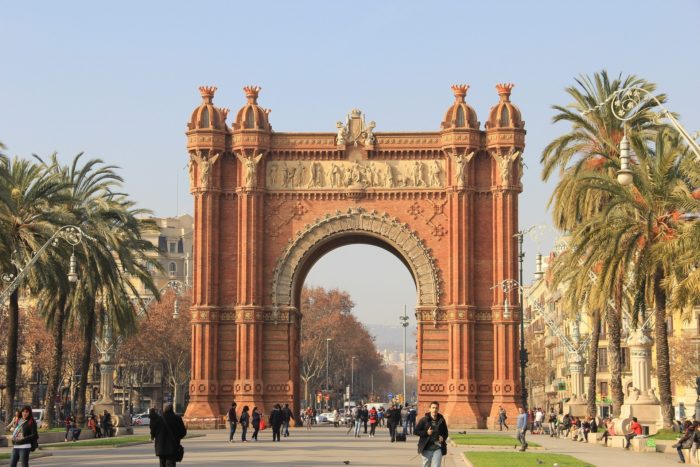12 Best Places to Live in Spain
Good food, good beaches, good architecture, good music, good (looking) people… We’ve all been exposed to a family member who just returned from Spain and can’t stop talking about it. “You just haveee to visit Barthelona.” But we aren’t here to talk about your cosmopolitan aunt’s recent trip.
Since 2019, the rate of US citizens moving to Spain and settling down has jumped by a whopping 13%. The majority of these are moving to the largest urban areas—Madrid, Barcelona, and Valencia. So what is driving Americans not just to visit, but fully settle down?

Between the reasonable cost of living when compared to other European countries, slower pace of life, and affordable private health insurance that won’t have you questioning whether or not to visit the doctor, Spain seems quite nice.
So if you’re also toying with the idea of a move to the land of La Mancha, we’ve outlined here the 12 best places to live in Spain—taking into account everything you need to know, from living costs to local languages (you heard us right, Spanish isn’t the only language spoken in Spain), climate and more!
Why move to Spain?
Okay, okay, okay—let’s not rush into things. Why move to Spain in the first place? Although we could drone on for days about everything Spain has up on the US, we’ve consolidated the top 4 qualities that have been making Spain so attractive to those from America and beyond:
- Affordable Healthcare – You heard it right the first time, affordable healthcare. Although as an American you won’t have access to their public health system, private health insurance still sums up to a fraction of what you’d pay in the US—think €50 to 200 a month max. Copay? What’s a copay.
- Safety – One noteworthy aspect of Spain’s safety lies in its strict firearm ownership regulation. Unlike the US where firearm-related incidents seem to span the news daily, Spain boasts stringent gun control measures. As a result, gun violence remains exceedingly rare, contributing to the overall sense of security and peace that envelops this picturesque nation.
- Lower Cost of Living – The affordability of life in Spain is driving expats from everywhere to this European peninsula. Prices are highest in Madrid and Barcelona, and lowest in smaller cities and pueblos, but nothing when compared to New York or LA. Take into consideration that local salaries compensate, making it ideal for you to come with remote work or savings.
- Slower Pace of Life – If you’re anything like us, you’ve felt drained by the hustle and bustle that is often life in the United States. Even in major cities of Spain, the pace of life is drastically slowed down, encouraging more time to meet with friends, go exploring, and enjoy the simple things in life slowwwwly—AKA you won’t find many people rushing to work with a coffee in their hand.
Want to know more about life in Spain? Check out our article on the pros and cons of life in Spain as well as our complete guide to living in Spain.
Best cities to live in Spain
Spain is home to a wide variety of cultures and languages. If you were to spend one day in San Sebastián and the next in Málaga, not only would you receive quite a culture shock, but the food, language, and landscape would make you think you changed countries entirely.
We’ve grouped the 12 best cities to live in Spain (on the mainland) into big, medium, and small populations, as this is one of the main influences on the cost of living as well as the pace of life. Ready to find your new home abroad? Let’s jump in.
Big cities (> 1 million)
1. Madrid
Nestled in the heart of Spain, Madrid holds an irresistible allure for those seeking a dynamic yet welcoming place to call home. With lots of singles, international families, digital nomads, and a large LGBTQIA+ community, the capital offers an array of captivating features that make it undoubtedly one of the best places to live in Spain.
Madrid provides a range of living options, accommodating various budgets. While it may be pricier than other Spanish cities, it remains more budget-friendly than many European capitals. Rent for a 1-bedroom apartment in the center (any area within or nearby the Manzanares River ) will cost about €900, metro and bus tickets cost €1.50, and groceries for 1 person cost anywhere from €30-50 per week.

The sunny Mediterranean climate in Madrid gifts residents with hot, dry summers and mild winters. Summer days often sizzle at temperatures surpassing 35°C (95°F), leading to an emptying-out of the city in July and August, while winters remain relatively mild. Madrid’s location also offers superb connectivity, both domestically and internationally. Adolfo Suárez Madrid-Barajas Airport, one of Europe’s busiest, ensures seamless access to many destinations around the globe.
Safety is a hallmark of Madrid, making it a secure haven for residents and tourists alike. While incidents of petty theft are known to occur, increasingly in the metro, major parks, and tourist hubs, violent crime rates remain remarkably low, on par with the rest of Spain.
Although it probably goes without saying, Madrid exudes culture at every turn, with a plethora of world-class museums, art galleries, and historic landmarks like the Palacio Real and Museo del Prado. The city’s vivacious street life, vibrant festivals, and deep appreciation for music, live theatre, and dance enrich its unique cultural fabric. Long story short, you’ll never be left without a new place to explore.
And one of our favorite aspects about Madrid has to be its diversity—not on par with cities like London, Paris or Berlin—but it still serves as a melting pot for Spaniards, Latin Americans, Chinese, Moroccans, Americans, and more. This diversity manifests itself beautifully in the city’s culinary landscape, where you can enjoy almost any cuisine you can think of.
If you need more convincing read more about why Madrid is a great place to live.
2. Barcelona
Second to the tortilla con o sin cebolla debate in Spain, lies the feud as to whether Madrid or Barcelona is the better city to live in. Some of the main differences to keep in mind include the language (the official language of Catalunya is Catalán, not Spanish), the beach, and the cost of living. We must confess that we’re biased here at She Hit Refresh, and, although Madrid is in dire need of a beach, we have been team Madrid for years now. But in the name of democracy we’ll let you arrive at your own conclusions.
Barcelona’s ideal location offers a perfect blend of coastal charm and mountainous grandeur. Along its eastern edge, pristine Mediterranean beaches like Barceloneta Beach provide a serene escape. Meanwhile, to the northwest, the impressive Montserrat Mountains beckon adventurers with opportunities for hiking, rock climbing, and exploration.
The city is also a haven for art and culture enthusiasts. Antoni Gaudí’s architectural masterpieces, like the Sagrada Família and Park Güell, dot the cityscape. Barcelona’s commitment to the arts is evident in its numerous museums, contemporary art galleries, and captivating street performances.

If your dream is to go car-free, Barcelona boasts one of the most well-connected public transport systems in Spain. Between the metro, bus, tram, as well as public bike service with plenty of cycling lanes, Barcelona makes living without a car easy.
Barcelona offers an array of living options but comes with one of the highest costs of rent in Spain. While 1-bedrooms around the central district surrounding the cathedral will cost upwards of €1400, non-central and suburban areas provide more affordable alternatives, we found as low as €750. Everyday expenses such as groceries are manageable all throughout Spain and similar to what we’ve seen in Madrid, and single metro tickets start at €2.40.
One of the main qualms we have with Barcelona is its rising crime rates as well as overwhelming amount of tourism. With the rise of tourism, thieves abound looking to score anything from phones to wallets, especially in central areas like La Rambla.
The overwhelming influx of tourists in Barcelona has become such an issue that locals have named this phenomenon parquetematización, referring to the increasing amusement park feel of the city. However, it’s crucial to note that violent crime remains relatively low, and by taking standard precautions, residents can enjoy the city safely.
Medium-sized cities (> 250,000)
3. Valencia
While Madrid and Barcelona often claim the spotlight, Valencia carves out its unique identity, offering an enticing blend of culture, landscape, and unique gastronomy—and at a more affordable price and high sense of safety. And as the third biggest city in Spain, it holds onto a strong cosmopolitan feel in the downtown business district.
Set apart from the rest of Spanish culture with its unique lively festivals, such as Las Fallas, mouth-watering paella, and unique language, Valenciano, Valencia has a strong singular identity. Many report that the entire comunidad somehow manages to have a warm, small-town feel, even in the city. Don’t be surprised if while sitting in Plaza de la Virgen or waiting for the bus, a stranger strikes up a friendly conversation with you—almost unheard of in Madrid or Barcelona these days.
On the more practical side of things, the cost of living in Valencia is about 17% cheaper than that of Madrid. Renting a 1-bedroom in the center averages €700-€900 per month, your average meal will range between €10-€20 per person, metro rides cost €1.50, and grocery shopping stays on par with the rest of Spain as well, €30-€50 a person.

With a delightful Mediterranean climate, Valencianos enjoy over 300 days of sunshine annually with generally mild winters—an outdoor-enthusiast’s paradise. Ideally situated on Spain’s eastern coast, overlooking the Mediterranean Sea, Valencia has the coastline to the east and the picturesque Sierra Calderona mountains to the west. You can’t forget unique pueblos such as Buñol, that offer opportunities for hiking just a short drive away.
For all you frequent flyers, the closest airport to Valencia is Aeropuerto de Valencia, also known as Manises Airport. It is conveniently located just a few kilometers west of the city center, providing easy access for both domestic and international flights. It’s eastern location also allows for quick flights to neighboring Spanish Mediterranean islands such as Ibiza, Menorca, and Mallorca.
4. Malaga
Nestled along the stunning Costa del Sol in southern Spain, Malaga is a slow-paced city that effortlessly combines the charm of traditional Andalusian culture with the convenience of modern living. Its unique location not only offers warm, sunny weather with mild winters, but also situates residents at a quick flight away from unique destinations like Morocco.
Malaga may seem like a small city at first glance but don’t be fooled—Malaga Airport, officially known as Malaga-Costa del Sol Airport, falls into the top 5 busiest airport in Spain, with 85% of its traffic being international. On par with its international connectivity, Malaga is home to a thriving community of international young professionals, digital nomads, and retirees, offering limitless opportunities to make friends, network, and date.

Although Malaga does have public transport, the most extensive one being the urban bus system, having a car comes in handy. Just a short drive from the city center, you’ll find yourself surrounded by breathtaking mountains. Between the Sierra de Mijas and Montes de Málaga, residents are provided with countless opportunities for hiking, mountain biking, and even skiing in the winter months.
One of the biggest changes that has been felt in Malaga are real estate prices. On par with the rest of Costa del Sol, Malaga has experienced the the fastest growing prices in Spain—going up 20% in the last year alone. But, we found rent prices for single-bedroom apartments in and around the center district to still be quite reasonable, starting at €900 a month and going up from there the more central, and spacious, you look.
5. Alicante
Traveling back east, we find ourselves transported to an expat favorite—sunny Alicante. This main city of the Costa Blanca is home to white sandy beaches, a vibrant waterfront, the castle of Santa Bárbara, an impressive mountainous landscape, mouth-watering local dishes like arroz a banda, a charmingly colorful old town, along with all of the modern amenities you would need.
Which a cost of living on par with nearby Valencia, rents average around €800 per month for a 1-bedroom apartment in a central district. Residents find it useful to have a car in Alicante as the public transport system works well locally, but falls short when you’re looking to explore neighboring cities like Altea, Benidorm, and Calpe or escape to the mountains.

Alicante enjoys a wonderfully diverse community, with residents hailing from various corners of the world, coming in via Alicante’s international airport. While the majority are Spanish, you’ll find yourself running into folks from the United Kingdom, Argentina, Ecuador, Morocco, Romania, Algeria, Colombia, and beyond. Thanks to its vibrant expat population in particular, although the official languages are Spanish and Valencian, you’ll find many residents who are fluent in English.
One thing to keep in mind in Alicante are its hot summers, but nothing that can’t be fixed with a strong AC unit or a day by the water. Its intense summers are balanced out by a pleasant climate the rest of the year, with mild winters that still allow for comfortable walks by the beach and hikes in the hills even in December.
6. Bilbao
Located in the cool northern Basque Country of Spain, Bilbao is a modern port city replete with history and renowned for its cool, cloudy weather—comparable to that of the UK. The official language of the Basque Country next to Spanish is Basque, also known as Euskera, an incredibly interesting, old, and challenging language. Although you can get along quite fine with Spanish, learning a few phrases will be much appreciated by the locals and assist with forming friendships.

Although the Basque country is known to be more expensive than other communities in Spain, we found one-bedroom apartments starting at €700 per month. Speaking of food, Bilbao is renowned for their unique gastronomy, most notably, pintxos, a larger (and, in our opinion, better) version of tapas that can be found throughout the entire Basque Country.
Although there’s not as strong of an expat presence as in other Spanish cities, you definitely won’t get bored. Bilbao makes it easy to have fun whether it’s exploring their Guggenheim museum, surfing at nearby beaches, celebrating local festivities, or hiking nearby mountains such as Pagasarri. Bonus? You’re sure to make friends with more locals and pickup the language this way.
7. Vitoria-Gasteiz
Located just 45 minutes inland from Bilbao, Vitoria-Gasteiz is the capital of the Basque Country. This medieval city, is consistently ranked within the top 5 places to live in Spain as well as the first Spanish municipality to win the European Green Capital, awarded for the abundance of green public areas, biodiversity, and strong local green policies.

If you’re drawn to the unique culture and language of the Basque Country or have always wanted to live in a medieval feeling location, without giving up modern amenities, Vitoria-Gasteiz could be a great fit. One-bedroom apartments are similarly priced to those of Bilbao, starting at €700/month. Although you can easily travel around the city in train, bike, or even on foot, you may need a car to travel around the rest of the Basque country and Spain with more ease.
Smaller cities (<250,000)
8. Marbella
This sunny, southern, coastal town isn’t just popular for retirees, but also many families and expats looking for sunny weather year round and a slow pace of life. With one of the best-known resorts on the Costa del Sol, it’s become somewhat of a magnet for expats—and tourists. Tourism is hottest from May to September, and slows down quite a bit from October to April, when the nightlife quiets down and the city empties out.

As we mentioned with Malaga, real estate prices are on the rise in this area of Spain, but we managed to find a few 1-bedroom apartments starting at €850 per month. You’ve got Málaga’s international airport right next door that you can reach with the daily shuttle buses that run between Málaga and Marbella. Although it’s technically a town, it offers all the amenities of a city and feels bigger as it runs into neighboring towns along the coast. And when you’re not exploring neighboring towns, or spending the day at the beach, you’ve got both the Sierra Nevada and Doñana National Parks right nearby that offer endless outdoor adventure opportunities.
9. Granada
Nestled an hour inland from the Mediterranean, Granada, a historic Moorish city, offers a captivating blend of culture and affordability. Set against the majestic Sierra Nevada Mountains, its affordable cost of living is quite surprising, with 1-bedroom apartments for as little as €400 per month, making it one of the cheapest places to live in Spain.
With easy access to both mountains and sea, Granada caters to skiing, sailing, and outdoor enthusiasts. Its elevation of 700 meters moderates the typically scorching Andalusian summers. Exploring this compact city on foot reveals vibrant shops, cozy cafes, and delectable tapas spots, minimizing the need for public transport.

Travelers benefit from the nearby Federico García Lorca Granada Airport, primarily serving domestic flights with occasional seasonal routes to Rome and Paris.
Although its expat community is small, it’s not too difficult to find native English-speakers roaming the streets or hitting up local coffee shops to work. While Spaniards dominate the population, there are also pockets of Latin American and North African communities and the friendly Andalusian locals make forming connections a breeze.
10. Girona
If you’re considering Catalonia, Spain, as your destination, look beyond Barcelona. Girona, just an hour inland from the Mediterranean coast, offers an enriching expat experience in a charming city that blends history with modern amenities.
Girona is a budget-friendly alternative to Barcelona, with 1-bedroom apartments starting at €700 per month. Located at the foothills of the Pyrenees Mountains, it offers a unique mix of mountain tranquility and Mediterranean allure. The city’s elevation ensures pleasant temperatures year-round, perfect for outdoor enthusiasts who enjoy activities like hiking and strolling along scenic riverbanks.

Girona’s compact size also makes it easy to navigate on foot or by bike, making it a delight to explore historic neighborhoods, cozy cafes, and vibrant shopping districts. While Catalan is the primary language, you’ll find Spanish widely spoken, with many residents proficient in English. Girona-Costa Brava Airport, conveniently located nearby, offers domestic flights and seasonal connections to select European destinations.
11. Jávea
Jávea, also known as Xàbia in Valenciano, is a sun-soaked coastal gem boasting a substantial British, Dutch, and American expat community, with nearly 7,000 year-round residents. Positioned conveniently between Valencia to the north and Alicante to the south, this triangular town encompasses three distinct areas: the historic Old Town, the inviting Arenal beach, and the charming Port.

Jávea is a haven for those seeking a tranquil beachside lifestyle and a warm expatriate community to embrace. Its allure is accentuated by a wealth of charming indoor and open-air markets, adding to its unique charm. What’s more, the cost of living here is notably reasonable, with one-bedroom apartments available for as little as €550 per month, making it an attractive choice for budget-conscious expatriates.
12. San Sebastian
Topping off our list, but by no means any less enticing, is the picturesque city of San Sebastian, also known as Donostia in the local Basque language. Nestled along the Bay of Biscay and just 20 kilometers from the French border, this charming northern gem has a lot to offer. San Sebastian is celebrated for its pristine beaches, delectable Basque cheese, mouthwatering pintxos (small tapas-like dishes), and the local language, Euskera.
The city’s popularity among internationals is on the rise, as evidenced by the growing number of coworking spaces catering to digital nomads from around the world.

It’s important to note that the Basque Country, in general, tends to have a higher cost of living and is known for its cloudy weather. In San Sebastian, you can expect monthly rental prices for one-bedroom apartments to range from €900 to €1,200, which is a bit steeper even when compared to Bilbao.
However, if this fits your budget, and you’re not scared of the rain, San Sebastian promises an abundance of cultural experiences, gastronomic delights, and natural beauty. Whether you’re attending the renowned San Sebastián International Film Festival, dining at Michelin-starred restaurants, taking surf lessons, or exploring neighboring France, San Sebastian has the feel of a large European cultural hub in a pocket size.
The best place in Spain to live
So, whether you’re seeking a fresh start, a retirement haven, or an adventurous change, Spain offers an open invitation to experience life at its most colorful. Your future may well be waiting amidst the cobblestone streets, the siestas, and the lively fiestas of this incredible country.
For continued support in your move abroad journey, make sure to:
- Join our Facebook Group for women age 30 and up
- Snag your copy of our Ultimate Visa Guide to Europe as an American
- Sign up for the next Move Abroad After 30 Masterclass to see if a move abroad is a possibility for you!
Embrace the opportunity, and let your journey to one of the 12 best places to live in Spain begin. We can’t wait to hear where you end up!



